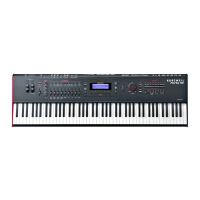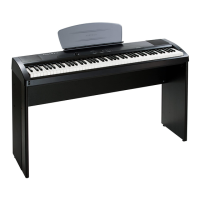Program Edit Mode
The Arpeggiator Function
7-61
one semitone. It adds that dierence to the original starting note (C4) and plays that note
next—C
#
4. e next note (F4) is within the shift limit, but the next note (A4) isn’t, so it gets
translated into D4—and so on.
FloatUnip uses the same concept and applies it to Unipolar mode: when the Arpeggiator
reaches the shift limit, it calculates the dierence between the next note and the limit, and
transposes the next cycle of notes down by that interval, then shifts each subsequent cycle
down until it reaches the original pitch.
FloatBip is similar to FloatUnip, but the downward shift limit isn’t the original pitch, it’s the
negative of the ShiftLimit value.
Key Range (Low Key and High Key)
e Arpeggiator processes notes within the range of these parameters. Notes outside the
specied range play normally, and do not become part of the arpeggiation sequence. When
the LoKey or HiKey parameter is selected, you can easily set the value by holding the Enter
button and striking the desired key. Key Range is not saved with each Arp Preset, but instead
is saved as part of each program (or Multi Zone). is allows you to try dierent presets
while maintaining the same Key Range.
Beats
e Beats parameter sets the number of notes per beat. e tempo is based on quarter notes.
erefore, if you set Beats to 1/4, you will get one note per beat of the clock. At 1/16, you
will get 4notes per beat, and so forth. e maximum value is 96 notes per beat (1/384), but
at most tempos, divisions smaller than 1/64 will sound pretty much the same.
To nd a Beats value, multiply the notes you want per beat by 4. For example, 4 notes per
beat (16th notes) would be 4*4=16, a Beats value of 1/16. ree notes per beat (8th note
triplets) would be 3*4=12, a Beats value of 1/12. Six notes per beat (16th note triplets)
would be 6*4=24, a Beats value of 1/24.
ShiftMode
Use the ShiftMode parameter to set how the arpeggiator will shift the pitch of played notes.
e Alg (algorithm) setting will let you create note sequences based upon a xed Shift
Amount. When you select Patt (pattern), the ShiftPatt parameter will appear, allowing you
to select a preset or user dened shift pattern. See ShiftPatt below for details.
ShiftLimit
When the Shift (Shift Amount) parameter is set to a value other than 0, ShiftLimit
determines how far up or down the Arpeggiator can shift the arpeggiated notes. Try setting
ShiftLimit to 12 or 24 to create an arpeggio that repeats the same pattern of notes in
dierent octaves. is works well when Shift (Shift Amount) is set to 12 or when a Shift
Pattern is selected.

